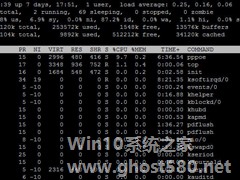-
线程同步的方法有哪些?Linux下实现线程同步的三种方法
- 时间:2024-04-26 02:33:49
大家好,今天Win10系统之家小编给大家分享「线程同步的方法有哪些?Linux下实现线程同步的三种方法」的知识,如果能碰巧解决你现在面临的问题,记得收藏本站或分享给你的好友们哟~,现在开始吧!
线程同步的方法有哪些?在linux下,系统提供了很多种方式来实现线程同步,其中最常用的便是互斥锁、条件变量和信号量这三种方式,可能还有很多伙伴对于这三种方法都不熟悉,下面就给大家详细介绍下。
Linux下实现线程同步的三种方法:
一、互斥锁(mutex)
通过锁机制实现线程间的同步。
1、初始化锁。在Linux下,线程的互斥量数据类型是pthread_mutex_t。在使用前,要对它进行初始化。
静态分配:pthread_mutex_t mutex = PTHREAD_MUTEX_INITIALIZER;
动态分配:int pthread_mutex_init(pthread_mutex_t *mutex, const pthread_mutex_attr_t *mutexattr);
2、加锁。对共享资源的访问,要对互斥量进行加锁,如果互斥量已经上了锁,调用线程会阻塞,直到互斥量被解锁。
int pthread_mutex_lock(pthread_mutex *mutex);
int pthread_mutex_trylock(pthread_mutex_t *mutex);
3、解锁。在完成了对共享资源的访问后,要对互斥量进行解锁。
int pthread_mutex_unlock(pthread_mutex_t *mutex);
4、销毁锁。锁在是使用完成后,需要进行销毁以释放资源。
int pthread_mutex_destroy(pthread_mutex *mutex);
- 01#include <cstdio>
- 02#include <cstdlib>
- 03#include <unistd.h>
- 04#include <pthread.h>
- 05#include "iostream"
- 06using namespace std;
- 07pthread_mutex_t mutex = PTHREAD_MUTEX_INITIALIZER;
- 08int tmp;
- 09void* thread(void *arg)
- 10{
- 11cout << "thread id is " << pthread_self() << endl;
- 12pthread_mutex_lock(&mutex);
- 13tmp = 12;
- 14cout << "Now a is " << tmp << endl;
- 15pthread_mutex_unlock(&mutex);
- 16return NULL;
- 17}
- 18int main()
- 19{
- 20pthread_t id;
- 21cout << "main thread id is " << pthread_self() << endl;
- 22tmp = 3;
- 23cout << "In main func tmp = " << tmp << endl;
- 24if (!pthread_create(&id, NULL, thread, NULL))
- 25{
- 26cout << "Create thread success!" << endl;
- 27}
- 28else
- 29{
- 30cout << "Create thread failed!" << endl;
- 31}
- 32pthread_join(id, NULL);
- 33pthread_mutex_destroy(&mutex);
- 34return 0;
- 35}
- 36//编译:g++ -o thread testthread.cpp -lpthread
二、条件变量(cond)
与互斥锁不同,条件变量是用来等待而不是用来上锁的。条件变量用来自动阻塞一个线程,直到某特殊情况发生为止。通常条件变量和互斥锁同时使用。条件变量分为两部分: 条件和变量。条件本身是由互斥量保护的。线程在改变条件状态前先要锁住互斥量。条件变量使我们可以睡眠等待某种条件出现。条件变量是利用线程间共享的全局变量进行同步的一种机制,主要包括两个动作:一个线程等待“条件变量的条件成立”而挂起;另一个线程使“条件成立”(给出条件成立信号)。条件的检测是在互斥锁的保护下进行的。如果一个条件为假,一个线程自动阻塞,并释放等待状态改变的互斥锁。如果另一个线程改变了条件,它发信号给关联的条件变量,唤醒一个或多个等待它的线程,重新获得互斥锁,重新评价条件。如果两进程共享可读写的内存,条件变量可以被用来实现这两进程间的线程同步。
1、初始化条件变量。
静态态初始化,pthread_cond_t cond = PTHREAD_COND_INITIALIER;
动态初始化,int pthread_cond_init(pthread_cond_t *cond, pthread_condattr_t *cond_attr);
2、等待条件成立。释放锁,同时阻塞等待条件变量为真才行。timewait()设置等待时间,仍未signal,返回ETIMEOUT(加锁保证只有一个线程wait)
int pthread_cond_wait(pthread_cond_t *cond, pthread_mutex_t *mutex);
int pthread_cond_timewait(pthread_cond_t *cond,pthread_mutex *mutex,const timespec *abstime);
4、激活条件变量。pthread_cond_signal,pthread_cond_broadcast(激活所有等待线程)
int pthread_cond_signal(pthread_cond_t *cond);
int pthread_cond_broadcast(pthread_cond_t *cond); //解除所有线程的阻塞
5、清除条件变量。无线程等待,否则返回EBUSY
int pthread_cond_destroy(pthread_cond_t *cond);
- 01[cpp] view plain copy
- 02#include <stdio.h>
- 03#include <pthread.h>
- 04#include "stdlib.h"
- 05#include "unistd.h"
- 06pthread_mutex_t mutex;
- 07pthread_cond_t cond;
- 08void hander(void *arg)
- 09{
- 10free(arg);
- 11(void)pthread_mutex_unlock(&mutex);
- 12}
- 13void *thread1(void *arg)
- 14{
- 15pthread_cleanup_push(hander, &mutex);
- 16while(1)
- 17{
- 18printf("thread1 is running\n");
- 19pthread_mutex_lock(&mutex);
- 20pthread_cond_wait(&cond, &mutex);
- 21printf("thread1 applied the condition\n");
- 22pthread_mutex_unlock(&mutex);
- 23sleep(4);
- 24}
- 25pthread_cleanup_pop(0);
- 26}
- 27void *thread2(void *arg)
- 28{
- 29while(1)
- 30{
- 31printf("thread2 is running\n");
- 32pthread_mutex_lock(&mutex);
- 33pthread_cond_wait(&cond, &mutex);
- 34printf("thread2 applied the condition\n");
- 35pthread_mutex_unlock(&mutex);
- 36sleep(1);
- 37}
- 38}
- 39int main()
- 40{
- 41pthread_t thid1,thid2;
- 42printf("condition variable study!\n");
- 43pthread_mutex_init(&mutex, NULL);
- 44pthread_cond_init(&cond, NULL);
- 45pthread_create(&thid1, NULL, thread1, NULL);
- 46pthread_create(&thid2, NULL, thread2, NULL);
- 47sleep(1);
- 48do
- 49{
- 50pthread_cond_signal(&cond);
- 51}while(1);
- 52sleep(20);
- 53pthread_exit(0);
- 54return 0;
- 55}
- 01#include <pthread.h>
- 02#include <unistd.h>
- 03#include "stdio.h"
- 04#include "stdlib.h"
- 05static pthread_mutex_t mtx = PTHREAD_MUTEX_INITIALIZER;
- 06static pthread_cond_t cond = PTHREAD_COND_INITIALIZER;
- 07struct node
- 08{
- 09int n_number;
- 10struct node *n_next;
- 11}*head = NULL;
- 12static void cleanup_handler(void *arg)
- 13{
- 14printf("Cleanup handler of second thread./n");
- 15free(arg);
- 16(void)pthread_mutex_unlock(&mtx);
- 17}
- 18static void *thread_func(void *arg)
- 19{
- 20struct node *p = NULL;
- 21pthread_cleanup_push(cleanup_handler, p);
- 22while (1)
- 23{
- 24//这个mutex主要是用来保证pthread_cond_wait的并发性
- 25pthread_mutex_lock(&mtx);
- 26while (head == NULL)
- 27{
- 28//这个while要特别说明一下,单个pthread_cond_wait功能很完善,为何
- 29//这里要有一个while (head == NULL)呢?因为pthread_cond_wait里的线
- 30//程可能会被意外唤醒,如果这个时候head != NULL,则不是我们想要的情况。
- 31//这个时候,应该让线程继续进入pthread_cond_wait
- 32// pthread_cond_wait会先解除之前的pthread_mutex_lock锁定的mtx,
- 33//然后阻塞在等待对列里休眠,直到再次被唤醒(大多数情况下是等待的条件成立
- 34//而被唤醒,唤醒后,该进程会先锁定先pthread_mutex_lock(&mtx);,再读取资源
- 35//用这个流程是比较清楚的
- 36pthread_cond_wait(&cond, &mtx);
- 37p = head;
- 38head = head->n_next;
- 39printf("Got %d from front of queue/n", p->n_number);
- 40free(p);
- 41}
- 42pthread_mutex_unlock(&mtx); //临界区数据操作完毕,释放互斥锁
- 43}
- 44pthread_cleanup_pop(0);
- 45return 0;
- 46}
- 47int main(void)
- 48{
- 49pthread_t tid;
- 50int i;
- 51struct node *p;
- 52//子线程会一直等待资源,类似生产者和消费者,但是这里的消费者可以是多个消费者,而
- 53//不仅仅支持普通的单个消费者,这个模型虽然简单,但是很强大
- 54pthread_create(&tid, NULL, thread_func, NULL);
- 55sleep(1);
- 56for (i = 0; i < 10; i++)
- 57{
- 58p = (struct node*)malloc(sizeof(struct node));
- 59p->n_number = i;
- 60pthread_mutex_lock(&mtx); //需要操作head这个临界资源,先加锁,
- 61p->n_next = head;
- 62head = p;
- 63pthread_cond_signal(&cond);
- 64pthread_mutex_unlock(&mtx); //解锁
- 65sleep(1);
- 66}
- 67printf("thread 1 wanna end the line.So cancel thread 2./n");
- 68//关于pthread_cancel,有一点额外的说明,它是从外部终止子线程,子线程会在最近的取消点,退出
- 69//线程,而在我们的代码里,最近的取消点肯定就是pthread_cond_wait()了。
- 70pthread_cancel(tid);
- 71pthread_join(tid, NULL);
- 72printf("All done -- exiting/n");
- 73return 0;
- 74}
三、信号量(sem)
如同进程一样,线程也可以通过信号量来实现通信,虽然是轻量级的。信号量函数的名字都以“sem_”打头。线程使用的基本信号量函数有四个。
1、信号量初始化。
int sem_init (sem_t *sem , int pshared, unsigned int value);
这是对由sem指定的信号量进行初始化,设置好它的共享选项(linux 只支持为0,即表示它是当前进程的局部信号量),然后给它一个初始值VALUE。
2、等待信号量。给信号量减1,然后等待直到信号量的值大于0。
int sem_wait(sem_t *sem);
3、释放信号量。信号量值加1。并通知其他等待线程。
int sem_post(sem_t *sem);
4、销毁信号量。我们用完信号量后都它进行清理。归还占有的一切资源。
int sem_destroy(sem_t *sem);
- 01#include <stdlib.h>
- 02#include <stdio.h>
- 03#include <unistd.h>
- 04#include <pthread.h>
- 05#include <semaphore.h>
- 06#include <errno.h>
- 07#define return_if_fail(p) if((p) == 0){printf ("[%s]:func error!/n", __func__);return;}
- 08typedef struct _PrivInfo
- 09{
- 10sem_t s1;
- 11sem_t s2;
- 12time_t end_time;
- 13}PrivInfo;
- 14static void info_init (PrivInfo* thiz);
- 15static void info_destroy (PrivInfo* thiz);
- 16static void* pthread_func_1 (PrivInfo* thiz);
- 17static void* pthread_func_2 (PrivInfo* thiz);
- 18int main (int argc, char** argv)
- 19{
- 20pthread_t pt_1 = 0;
- 21pthread_t pt_2 = 0;
- 22int ret = 0;
- 23PrivInfo* thiz = NULL;
- 24thiz = (PrivInfo* )malloc (sizeof (PrivInfo));
- 25if (thiz == NULL)
- 26{
- 27printf ("[%s]: Failed to malloc priv./n");
- 28return -1;
- 29}
- 30info_init (thiz);
- 31ret = pthread_create (&pt_1, NULL, (void*)pthread_func_1, thiz);
- 32if (ret != 0)
- 33{
- 34perror ("pthread_1_create:");
- 35}
- 36ret = pthread_create (&pt_2, NULL, (void*)pthread_func_2, thiz);
- 37if (ret != 0)
- 38{
- 39perror ("pthread_2_create:");
- 40}
- 41pthread_join (pt_1, NULL);
- 42pthread_join (pt_2, NULL);
- 43info_destroy (thiz);
- 44return 0;
- 45}
- 46static void info_init (PrivInfo* thiz)
- 47{
- 48return_if_fail (thiz != NULL);
- 49thiz->end_time = time(NULL) + 10;
- 50sem_init (&thiz->s1, 0, 1);
- 51sem_init (&thiz->s2, 0, 0);
- 52return;
- 53}
- 54static void info_destroy (PrivInfo* thiz)
- 55{
- 56return_if_fail (thiz != NULL);
- 57sem_destroy (&thiz->s1);
- 58sem_destroy (&thiz->s2);
- 59free (thiz);
- 60thiz = NULL;
- 61return;
- 62}
- 63static void* pthread_func_1 (PrivInfo* thiz)
- 64{
- 65return_if_fail(thiz != NULL);
- 66while (time(NULL) < thiz->end_time)
- 67{
- 68sem_wait (&thiz->s2);
- 69printf ("pthread1: pthread1 get the lock./n");
- 70sem_post (&thiz->s1);
- 71printf ("pthread1: pthread1 unlock/n");
- 72sleep (1);
- 73}
- 74return;
- 75}
- 76static void* pthread_func_2 (PrivInfo* thiz)
- 77{
- 78return_if_fail (thiz != NULL);
- 79while (time (NULL) < thiz->end_time)
- 80{
- 81sem_wait (&thiz->s1);
- 82printf ("pthread2: pthread2 get the unlock./n");
- 83sem_post (&thiz->s2);
- 84printf ("pthread2: pthread2 unlock./n");
- 85sleep (1);
- 86}
- 87return;
- 88}
以上便是Linux下实现线程同步常用的三种方法,大家都知道,线程的最大的亮点便是资源共享性,而资源共享中的线程同步问题却是一大难点,希望小编的归纳能够对大家有所帮助!
以上就是关于「线程同步的方法有哪些?Linux下实现线程同步的三种方法」的全部内容,本文讲解到这里啦,希望对大家有所帮助。如果你还想了解更多这方面的信息,记得收藏关注本站~
『*文章★来自Win10系统之家www.ghost580.net,转载请联系本站网管!』
相关文章
-

线程同步的方法有哪些?在linux下,系统提供了很多种方式来实现线程同步,其中最常用的便是互斥锁、条件变量和信号量这三种方式,可能还有很多伙伴对于这三种方法都不熟悉,下面就给大家详细介绍下。
Linux下实现线程同步的三种方法:
一、互斥锁(mutex)
通过锁机制实现线程间的同步。
1、初始化锁。在Linux下,线程的互斥量数据类型是... -

为避免造成系统额外空间的浪费,扩展XFS文件系统是很有必要的,那么在Linux下要如何扩展XFS文件系统呢?下面小编就给大家介绍下Linux扩展XFS文件系统的方法。
Linux扩展XFS文件系统步骤:
XFS是一个开源的(GPL)日志文件系统,最初由硅谷图形(SGI)开发,现在大多数的Linux发行版都支持。事实上,XFS已被最新的CentOS/RHEL7采... -

因为RAID磁盘阵列的存储速度比单个硬盘高,在安装系统的时候一般会选择搭建在RAID磁盘阵列,下面小编就给大家介绍下RAID磁盘阵列搭建Linux系统的方法。
新配了台电脑,准备装个双系统,windows用来打游戏,linux用来写代码。专门买了两块1T硬盘,想用来搭建RAID0,使用并行I/O来提升电脑的性能。
选主板的时候刻意选了支持RAID的主板,msi... -

Linux系统网络性能可以用工具来测试,主要的测试工具有route、netstat、tcpdump。本文就来分别介绍一下Linux系统下使用这三种工具调试网络性能的方法。
一:route
在配置网络时,要为机器指定接收数据包时该包要经过的路径。在Linux系统中,提供一个命令route,这个命令可以为ifconfig命令配置的网卡设置静态路由。这种设置工作通常...




